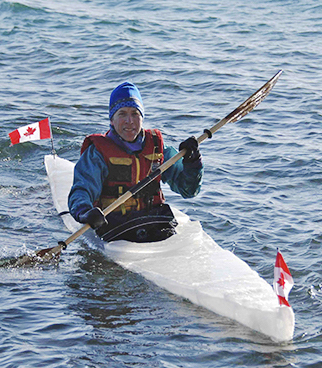
Day 9: Paul Berger's Interacting with an Embodied Continuum
 | Name: Dr. Paul Berger Area/Discipline: Faculty of Education |
The Technique
On the first day of my climate-change education classes, I use an embodied continuum technique to get students actively involved. This also helps me to see my students’ baseline knowledge. The activity further opens up the opportunity to share the value/impact of my course, connected to their program experience:
Since we have the technology and knowledge to sharply reduce greenhouse gas(GHG) emissions in line with what the science tells us is required, climate activism is needed. This course will help to identify and take steps on this path.
I use three questions that ask my students to respond by moving their bodies to spaces on a continuum that stretches across the classroom. They must find the location that best represents their answer. The questions work in both on-campus and online spaces. When the activity is delivered online, I use the chat window to have the students respond by locating themselves numerically in relation to other learners’ answers.
Unlike a typical Q and A where most students can be passive, this requires people to think, take a position (literally), and share it -- with the added benefit (in-person) of getting people moving a bit.
This activity sets the stage for diving into learning more about climate change, climate justice, climate solutions, and teaching or raising awareness about climate change. It could also work well with many topics related to climate change, whether in English, Kinesiology, Chemical Engineering, or… your area!
How I Use It
Three questions are used for this activity:
- How concerned are you about climate change? (From not concerned to extremely concerned)
- How much of the technology and knowledge to tackle climate change and save much of what we love do you think we have? (From not much of the technology and knowledge to all of the technology and knowledge)
- How confident are you that we will collectively act and implement the technology and knowledge we have to avoid catastrophic climate change and save much of what we love? (Not at all confident to completely confident)
Students' responses to these questions are brief, and I try to keep my comments short so that each question is completed in about five minutes. The steps taken are:
- I pose the first question, and then ask each student to answer the question by placing themselves on an imaginary line in relation to where other students are placing themselves.*
- After students have completed this task, I ask students at both ends of the continuum to share why they placed themselves at an endpoint.
- Next, I ask others to volunteer why they placed themselves where they did on the continuum (with the people closest to them encouraged to share next).
- I move on to the second question and repeat the process.
- I complete the activity by posing the final question.**
Note: For question one, students often place themselves between an imaginary 5 and 10 on the line (representing concern), with most people clumped around 8, 9, and 10. In question two, due to a little more “spread,” I can share that the International Energy Agency has said that we have all of the technologies we need for the huge reductions in GHGs necessary by 2030. Most people are not confident that we will collectively act, citing things such as government/big corporations partnerships as a reason. I’m able to follow this by stating that recent scientific findings, extreme weather, and activism have pushed climate action way up on the political agenda!
* During online delivery, I ask people to put a number from 1 to 10 in the chat, rather than arranging themselves in a line representing a continuum.
** Another chance to speak in breakout rooms could be valuable as a debrief -- after some instructor comments are shared about how activism has pushed things up the political agenda.
Feedback from Learners
Students seem to be energized by the movement and discussion with others. This activity allows students to see that they are not alone in being concerned but also that, while things may currently look bleak, we have the chance to engage and be part of changing that calculus.
Supporting Goal 13
Take urgent action to combat climate change and its impacts
This technique may support change or development in this area by encouraging people to engage with climate activism which, for me, includes simply talking to others about climate change. Since what we now lack is the political will to tackle climate change with the seriousness necessary, all actions that increase citizen awareness are valuable.
Seeing that other people care and are concerned as well as learning that we don’t have a technology gap so much as an implementation gap may encourage people to risk leaving their comfort zones and join the push for climate justice and a livable planet.
A short task to challenge you!
Consider, and then answer, the following three questions by placing yourself on each of these continuua:
One Final Task
Is this something you can use in your classroom? How might you utilize it? If you share your results somewhere on social media, please let us know by using the hashtag #12tech21LUDay9.
![]()
12 Techniques of the Holidays 2021 by Teaching Commons@LU is licensed under a Creative Commons Attribution-NonCommercial-ShareAlike 4.0 International License.

